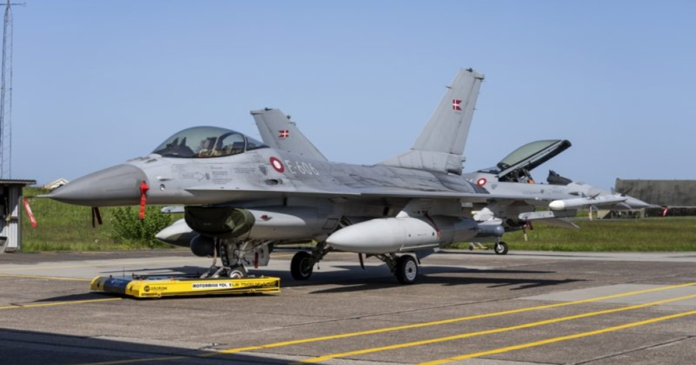According to a US official, the US has given the go-ahead for Denmark and the Netherlands to send F-16 fighter jets to Ukraine to protect against Russian forces after pilot training is finished.
US approves sending F-16s to Ukraine: To assist it challenge Russian air superiority, Ukraine has actively sought out the US-made F-16 fighter fighters.
According to the official, the US administration assured representatives from Denmark and the Netherlands that it would accelerate the clearance of transfer requests for F-16s to be sent to Ukraine once the pilots had received their training.
Recently, those assurances had been requested by the Netherlands and Denmark. The transfer of the military aircraft from the US’ allies to Ukraine requires US approval.
This month in Denmark, a coalition of 11 nations was scheduled to begin training Ukrainian pilots to operate the F-16 combat jets.
Troels Poulsen, the interim defence minister for Denmark, stated in July that the nation intended to see “results” from the training in the first quarter of 2024.
Denmark and the Netherlands, both NATO members, have been at the forefront of international efforts to train pilots and other support personnel, repair aircraft, and ultimately make it possible for Ukraine to acquire F-16s for use in its conflict with Russia.
“US Assures Transfer of F-16s to Ukraine and Pilot Training, Antony Blinken’s Letters Confirm”
According to the US official, Secretary of State Antony Blinken wrote letters to his Dutch and Danish counterparts assuring them that the requests would be granted.
“I am writing to express the United States’ full support for both the transfer of F-16 fighter aircraft to Ukraine and for the training of Ukrainian pilots by qualified F-16 instructors,” Mr. Blinken said in a letter to the two officials, a copy of which was seen by Reuters.
As Mr. Blinken stated, “Ukraine’s ability to defend itself against ongoing Russian aggression and violation of its sovereignty remains crucial.”
He said that if the demands were granted, Ukraine would be able to “full-advantage of its new capabilities as soon as first set of pilots complete their training.”
In May, US Vice President Joe Biden backed training initiatives for Ukrainian F-16 pilots. In addition to Denmark, a training facility was to be established in Romania.
According to Yuriy Ihnat, a spokesman for Ukraine air force, who was speaking to Ukrainian television late on Wednesday, Kyiv won’t be allowed to fly F-16 fighter jets made in the US this upcoming autumn and winter.
US officials have privately stated that given Russian air defence systems and contested airspace above Ukraine, F-16 planes would not have been much help to Ukraine in its current counteroffensive and will not be game changer when they eventually come.
The latest in a wave of assaults on the nation’s capital and the strategic waterway, according to Russian officials, involved the destruction of Ukrainian drones that were aiming at Moscow and the Black Sea Fleet.
A Ukrainian drone was shot down by Russian air force early this morning, according to Russian defence ministry.
The mayor of Moscow stated that although emergency personnel were on the scene, preliminary information suggested there were no injuries.
“Drone Attack Fallout: Wreckage Hits Expo Centre Near Moscow, Aviation Service Closes Airspace”
According to Sergei Sobyanin on Telegram, “the UAV wreckage fell in the vicinity of the Expo Centre, but did not significantly damage the building.”
Further, According to emergency personnel, one of the pavilion’s walls had partially fallen, according to state-run news agency TASS.
According to the aviation service, TASS reported that they briefly closed the airspace in the vicinity of Vnukovo International Airport, which resulted in delays for departures and arrivals.
The expo centre, located on the Krasnopresnenskaya embankment of the Moskva River, frequently conducts exhibitions and trade events.
The location is 100 yards from Moscow-City, an office complex in the major commercial sector of the capital that was struck twice in a matter of days by drone attack debris this month.
The capital has not been attacked during the conflict in Ukraine, which started more than a year ago, until a string of attacks in recent months.
A Ukrainian drone was shot down by Russia last week over Moscow’s western suburbs, and the wreckage landed in a park on the Karamyshevskaya embankment.
Less than 5 kilometres from the Expo Centre in May, drones were shot down close to the Kremlin.
On July 30, President of Ukraine, Volodymyr Zelensky, issued a warning of imminent “war,” stating that “symbolic centers and military bases” in Russia would be targeted.
The latest in a series of attacks on its fleet, Russia said it stopped a Ukrainian marine drone attack on its vessels in the Black Sea hours before the hit on Moscow.
Reportedly, Russian naval patrol ships destroyed the drone late last night, approximately 237 kilometers southwest of Sevastopol. Sevastopol is the base of the Black Sea Fleet situated on the Crimean peninsula, which has been occupied by Moscow.
“Increased Tensions: Attacks in the Black Sea Amid Russia-Ukraine Contract Dispute”
Since Russia backed out of a contract that had allowed for the secure transport of Ukrainian grain through the maritime centre, attacks in the Black Sea have increased on both sides.
On August 4, Russia claimed to have thwarted a drone attack from Ukraine, while a Ukrainian security source asserted that the attack on a warship at the base had indeed succeeded.
A civilian cargo ship from Ukraine made it to Istanbul through the Black Sea in violation of a Russian blockade hours before the attack.
Last month, Moscow declared that it would consider any ships approaching Ukraine in the Black Sea as potential carriers of military supplies.
According to President Zelensky, the ship was utilising a “new humanitarian corridor” that Kyiv constructed following the failure of the grain deal.
A Russian navy ship boarded a Turkish-owned cargo ship flying the Palau flag and en route to a Ukrainian river port, days earlier, after firing warning shots.
Following the cancellation of the grain contract, Russia has intensified its attacks on Ukraine’s port infrastructure in the Black Sea and on the Danube River – a critical export route.
Amid Russia’s efforts to regulate trade on the Black Sea, Ukrainian forces have initiated a military counteroffensive in the background. This counteroffensive, which began in June and is supported by new Western equipment, is progressing slowly.

